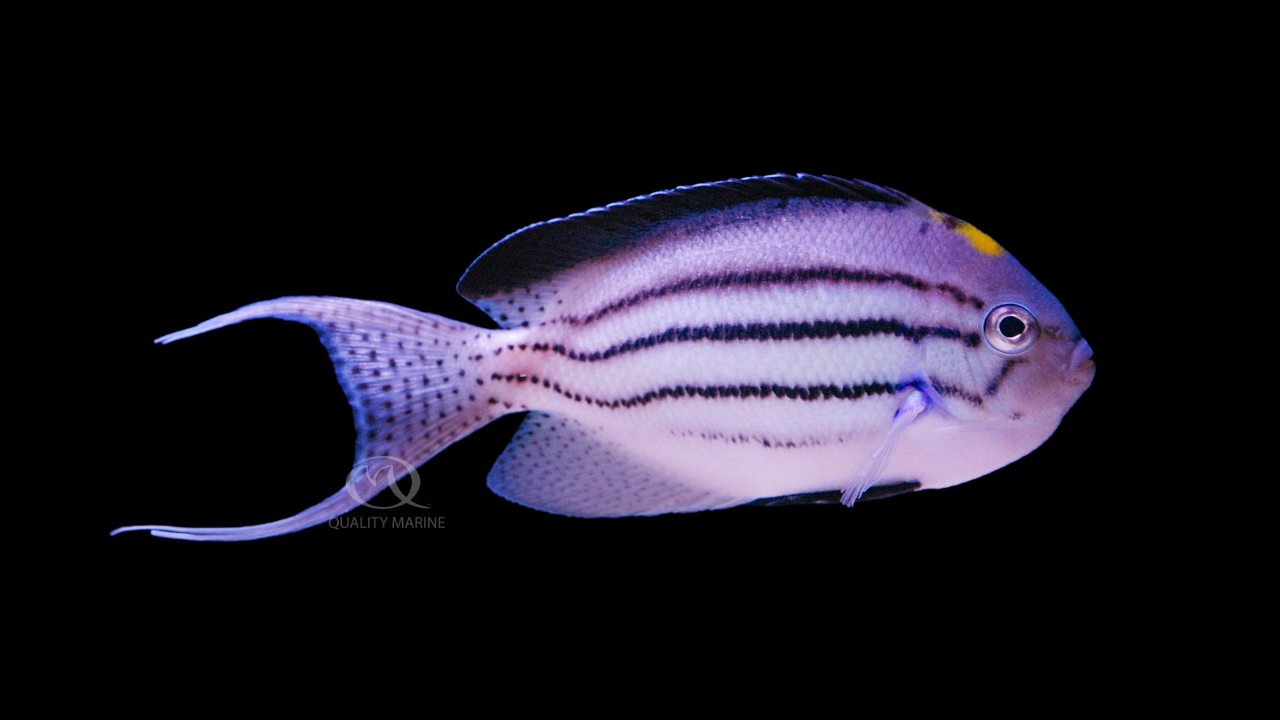The Remarckable Lamarck

The marine aquarium hobby has many Angelfish that are not safe for aquariums with invertebrates, in fact, the vast majority of Angelfish fit into this category. Fish from the Genus Pomacanthus, Holacanthus, Chaetodontoplus, Apolemichthys will (sooner than later) try to eat your corals. It's been our experience that this is true of every genus of Angel except for one and we are not referencing Centropyge. While many hobbyists report long-term keeping of individual dwarf Angels in their reef style aquariums, it's been our experience (over the last 5 decades of fish keeping) that even these fish usually break with their good behavior model at some point and head to the coral polyp buffet.
There is one genus of marine Angel that is about as reef safe as any fish can be, and that is Genicanthus, or the Swallowtail Angels. Among these, one of our staff favorites is Lamarck's Angel. These shy fish are planktivores in the wild, and very used to eating suspended foods. This not only makes them easy to feed, as they will sample just about anything floating past that will fit into their small mouths, but they don't really graze on rocks or corals, enhancing their low risk profile.
Lamarck's Angels live near shallow tropical reef crests, near drop offs or above deep reefs. They live in harems (one male and several females) of around five to seven individuals and form larger aggregations during the day when they feed. These fish spend little or no time near the bottom except when the sleep in the cracks and crevices of the reefs they live near. Their range is where ever these conditions exist in the Indian Ocean, and the Red and Coral Seas.

Genicanthus Lamarck can get up to nine inches long in the wild, and as such are occasionally harvested as food fish, but are more commonly exported for aquarium viewing, and they are excellent for this. On average, an adult Lamarck's is more like six or seven inches long, making them suitable for displays as small as 110 gallons. This is a slow growing fish, and so could be kept in a smaller aquariums for a while until they reach maturity. These tanks should have enough open space for this fish to swim freely in, but enough rocks to provide cover enough for sleeping in. They will appreciate quite a bit of turbulent current to mimic their preferred habitat in the wild. Temperatures can be as high as 78 degrees Fahrenheit, but they can also live in cooler water aquariums, down into the high 60s without any problem.
These fish can be kept as single specimens, and if you choose to keep them this way, they are likely to turn into males (unless you start with a male obviously). We suggest keeping them in small harems, of three to seven fish with one male. If you are keeping three or four, you could start with all females and the most dominant of these fish will turn male in time. This is not a fast process, but it will happen. In regards to other tank mates, this is a very peaceful fish, even with other Angels, and as such, your primary concern is housing them with fish that are too aggressive. For this reason we don't suggest keeping them with other, larger angels, or with triggers. Adult Lamarck's will develop long tail streamers (like the tail of a swallow – thus the name “swallowtail”) and so fish that would pick on these streamers like Pufferfish are also probably not a great choice. As was referenced previously, we have found them to completely ignore corals, clams and even clean up crews.
These are hardy fish and will require no weird water quality parameters. If you are successfully keeping invertebrates like corals, you should have no problem keeping Lamarck's Angels. They are very active, and so should be fed more than once a day. Here we feed them a mix of small thawed foods from Gamma like mysis and finely chopped prawn and mussel as well as the awesome pellets from Nutramar, this happens twice a day. In your home environment, three or four smaller feedings would be great, and an autofeeder could help you administer regularly timed dry foods while you were out. We find them to generally take to prepared diets very quickly and they perform really well for us in house.
Occasionally, you will also see Genicanthus lamarck offered under the common names: Blackstripe Angel, and Freckletail, or Lyretail Angel. Regardless of what you call it, Lamarck's Angel is our number one recommendation for an angel in a reef environment, and honestly, for most fish tanks in general. This fish is peaceful and hardy, takes well to aquarium foods, is as reef safe as any fish ever is and is gorgeous to boot. If you're interested in trying a harem of them, head to your Local Fish Store and ask them about sustainably sourced Larmark's Angels from Quality Marine Today!